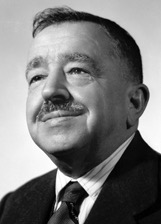The Carabinieri are the national gendarmerie of Italy who primarily carry out domestic policing duties. It is one of Italy's main law enforcement agencies, alongside the Polizia di Stato and the Guardia di Finanza. As with the Guardia di Finanza but in contrast to the Polizia di Stato, the Carabinieri are a military force. As the fourth branch of the Italian Armed Forces, they come under the authority of the Ministry of Defence. In practice, there is a significant overlap between the jurisdiction of the Polizia di Stato and Carabinieri, who are contacted on separate emergency telephone numbers. Unlike the Polizia di Stato, the Carabinieri have responsibility for policing the military, and a number of members regularly participate in military missions abroad.

Riot control refers to the measures used by police, military, or other security forces to control, disperse, and arrest people who are involved in a riot, demonstration, or protest. If a riot is spontaneous and irrational, actions which cause people to stop and think for a moment can be enough to stop it. However, these methods usually fail when there is severe anger with a legitimate cause, or the riot was planned or organized. Law enforcement officers or military personnel have long used less lethal weapons such as batons and whips to disperse crowds and detain rioters. Since the 1980s, riot control officers have also used tear gas, pepper spray, rubber bullets, and electric tasers. In some cases, riot squads may also use Long Range Acoustic Devices, water cannons, armoured fighting vehicles, aerial surveillance, police dogs or mounted police on horses. Officers performing riot control typically wear protective equipment such as riot helmets, face visors, body armor, gas masks and riot shields. However, there are also cases where lethal weapons are used to violently suppress a protest or riot, as in the Boston Massacre, Haymarket Massacre, Banana Massacre, Hungarian Revolution of 1956, Kent State Massacre, Soweto Uprising, Mendiola Massacre, Bloody Sunday (1905), Bloody Sunday (1972),Venezuelan Protest(2017),Tuticorin Massacre (2018)

Riot police are police who are organized, deployed, trained or equipped to confront crowds, protests or riots.
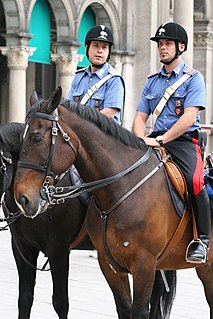
Law enforcement in Italy is an exclusive duty of the State and it is generally provided by four national agencies with full powers, with other local forces providing restricted or limited duties.

Arturo Bocchini was Chief of Police under the Fascist regime of Benito Mussolini. From 1926 until his death in 1940, Bocchini headed both the regular police and the secret political police (OVRA).

The Autoblinda 40, 41 and 43 were Italian armoured cars produced by Fiat-Ansaldo and which saw service mainly during World War II. Most autoblinde were armed with a 20 mm Breda 35 autocannon and a coaxial 8 mm machine gun in a turret similar to the one fitted to the Fiat L6/40, and another hull mounted rear-facing 8 mm machine gun.

Roma Termini is the main railway station of Rome, Italy. It is named after the district of the same name, which in turn took its name from ancient Baths of Diocletian, which lie across the street from the main entrance.
The General Investigations and Special Operations Division, generally known by its acronym DIGOS, is an Italian law enforcement agency charged with investigating sensitive cases involving terrorism, organized crime and serious offences such as kidnapping and extortion. It is a special operational division of Polizia di Stato, territorially organized within each provincial police headquarters. It is responsible to the national Central Police Directorate for Crime Prevention, which is a part of the Public Safety Department of the Interior Ministry. The DIGOS, which has an Office in each provincial headquarters, or Questura, of the Polizia di Stato acts as its Intelligence branch. Through "general investigations" aimed at having a constant eye on the evolution on national soil of social unrest, political underground movements and sports-related violent phenomena the DIGOS periodically reports to the Minister of Interior and to the Head of Police. Such activity is strongly assisted by the peculiar and specially trained infiltration units belonging to DIGOS that constantly enrich such reports and investigations with "inside views" of the various phenomena. Special training of such units involves classes on local slang, specific environment habits and social camouflage along with prior real life experiences as a selection preference).
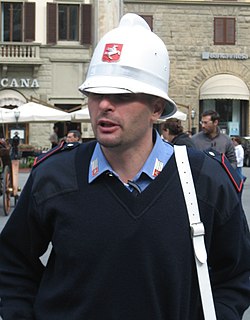
The polizia municipale are the municipal police of Italy responsible to the mayors of the various municipalities of Italy. Traffic control is their main function in addition to enforcing national, regional and local laws regarding commerce, legal residence, pets and other administrative duties. They also have all other police duties, with the exception of public safety, because this is an exclusive duty of the Polizia di Stato and Polizia Municipale has only an auxiliary function. Thus, its member aren't automatically authorized to carry weapons while in their line of duty. On the contrary, each municipality decides whether to arm its municipal police corp.

The De Tomaso Deauville was a luxury four-door saloon first exhibited at Turin Motor Show 1970. The Deauville was powered by the same 351 in³ (5763 cc) Ford Cleveland V8 as the De Tomaso Pantera, rated at 330 hp. The car had a top speed of 230 km/h (143 mph) and featured styling similar to that of the Jaguar XJ.
The Polizia Stradale is the national highway patrol of Italy and is a sub-directorate of the Italian State Police.

The Raggruppamento Operativo Speciale (ROS), or Special Operations Group, is part of the Italian Carabinieri. Founded on 3 December 1990 to coordinate investigative activities against organized crime, it is now the main investigative arm of the Carabinieri, dealing with organized crime and terrorism. The ROS reports directly to the Carabinieri General Command.
The Republican Police Corps was a police force of the Italian Social Republic during the Italian Civil War.
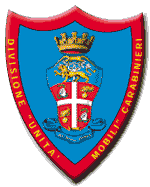
The Carabinieri Mobile Units Division is the Carabinieri formation, established in 2001, dedicated to the performance of military duties abroad, the military police tasks when abroad, the support to Territorial Organization, the participation in civil protection operations and to ensure the emergency reserve for the General Command.
The 1st Carabinieri Mobile Brigade is a Carabinieri formation tasked with riot control, civil defence and security duties.

The 2nd Carabinieri Mobile Brigade, based in Livorno, is the Carabinieri formation dedicated to the military missions abroad, including the military police tasks. It employs the 13th Carabinieri Regiment "Trentino-Alto Adige", the 13th Carabinieri Regiment "Friuli-Venezia Giulia", the 1st Parachute Carabinieri Regiment "Tuscania" and the Gruppo di intervento speciale.

The 1st Carabinieri Regiment "Piemonte" is a riot control unit of the Carabinieri.
The 4th Carabinieri Battalion "Veneto" is a Carabinieri formation tasked with riot control, civil defence and security duties.
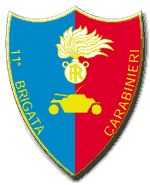
The 11th Carabinieri Mechanized Brigade was the Carabinieri formation, established in 1963 and disestablished in 2001, dedicated to the performance of military duties, the support to Territorial Organization, the participation in civil protection operations and to ensure the emergency reserve for the General Command.










